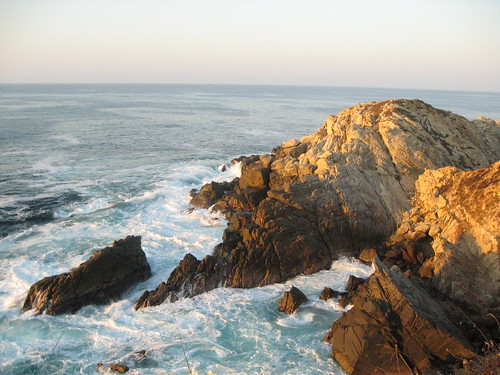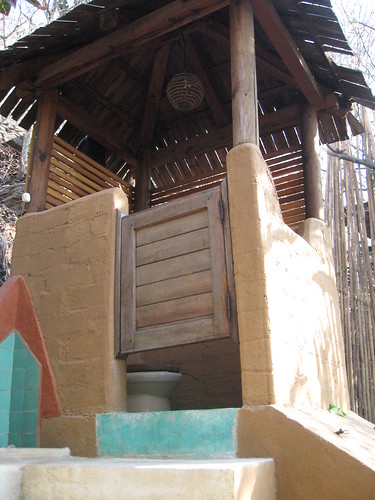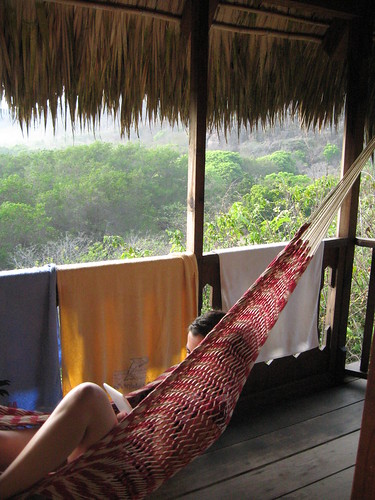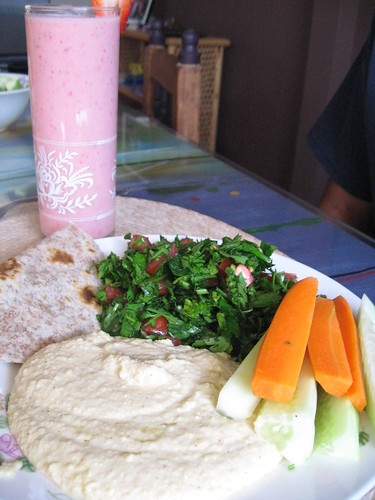
During the first week of March, Maru and I spent 4 nights on an ideal beach vacation in the small town of Mazunte, Oaxaca on the Pacific coast. We took a bus (12 hours!) from Puebla and arrived early in the morning in Pochutla where we took a 30 minute cab ride to our hotel, El Copal, in Mazunte.
Mazunte and neighboring San Agustinillo used to be key towns in the trade of sea turtle meat and eggs until the government banned the industry in the mid 90s. After that, they turned the economy around and now focus on conservation and tourism. It´s still a sleepy little place. Most of the tourists are European hippies, and there´s a little European (mainly Italian from my impression) ex-pat population as well. There are four major beaches, all gorgeous, and the water is a little rough for swimming at times. Mazunte is good for surfing if that tells you anything.
Our hotel, or posada, El Copal is located overlooking la Playa Mermejita, the least developed of the main beaches. The place is about a 15 minute walk from town, which gives it a remote location in a remote town. Perfect. It´s considered eco-friendly as well; the power is all solar generated, there are no water heaters, and the toilets in each cabaña are dry, ecological toilets. I know, you may be thinking of an outhouse or pit toilet. I had a few experiences with those at campgrounds in Michigan. Those are gross. A quality eco-toilet, however, is a thing of beauty. There is no plumbing involved. The toilet sits on top of a pit and has a compartment in the front that collects urine and you poop into the hole then throw in some ashes then sawdust which absorb moisture and promote virtually smell free decay. From the way ours was set up, I think they could empty out the bottom in order to compost everything. No bugs, no stink, no water! And in this particular toilet´s case, you could see the ocean while you sat on it. Nice touch!

The shower was also mounted outdoors with a view of the ocean. It was positioned in a way that protected your privacy but let you bathe in the open air, which felt great in the hot weather.
So, we had a nice place to stay. The little restaurant there is very tasty. Breakfast is a little pricey for the area, but we had dinner and mezcal cocktails there one night and it was spectacular; queso panela topped with shallots, garlic, basil and olive oil followed by a perfectly cooked steamed fish fillet with rosemary and zucchini. Yummy.
Our daily routine consisted of walking into town for breakfast, walking to the beach of our choice, then doing the beach thing; relaxing, swimming, reading, eating fish, drinking beer, playing the travel version of Settlers of Catan, body boarding, exploring tide pools, and just watching the surf. We spent one morning in the town of Ventanilla (a few miles away from Mazunte) where there is a community cooperative that has undertaken the conservation and reforestation of a mangrove lagoon. The mangroves were devastated by hurricanes in 1996 and 1997 losing up to 70% of the forest. The community has painstakingly been raising mangroves from seeds and replanting them ever since, offsetting the cost by offering guided tours of the lagoon. There is all sorts of flora and fauna; lots of bird species, turtles, and, infamously, crocodiles. It was definitely worth a visit.
We also visited the Turtle Museum, which was built after the end of the turtle hunting. It´s a place for education and conservation. Out of the 11 species of marine turtle in the world, 9 can be found off the Mexican coast and one actually only lays eggs on one beach on the Gulf side. Several species nest near Mazunte. The folks at the museum will often collect the eggs to keep them protected, incubate them, then release the babies on the beach where they were laid. They also collect injured animals to nurse them back to health and rerelease them if possible. Sea turtles are amazing animals to see up close. We were also impressed with the fact that this little town managed to turn it´s economy around, from slaughtering thousands of turtles a day to being a hub for conservation.
We got ourselves out of bed at about 5:30 another morning and hiked to Punta Cometa near our hotel. It´s an outcrop of rocks on a cliff and we had a perfect view. Exploring the rock structures was one of my favorite activities. I love tide pools, and the ones in Mazunte are exploding with several species of crabs, including the one called Mazunte, a little blue, red, and yellow guy. I caught two crabs battling it out at one point and actually spitting water. It looked like a water gun. I think maybe I´ve seen something like that in a documentary, but it was kind of hilarious to see it in real life.
Obviously, all of the seafood we ate was great, but not just the seafood. There is an Italian restaurant in Mazunte called “La Dolce Vita” run by some of the aforementioned expats. Hands down the best Italian food I have eaten in Mexico and on par with some of the best I´ve eaten in the US. They make fresh pasta and brick oven pizzas, and the lasagna we had there was perfect. Oh, and their tiramisu was nothing short of spectacular. We went there two nights in a row and got it both times.
Mazunte was just what we needed to unwind and get our mind off of waiting to hear from the visa office about Maru´s green card. I had been dying for a beach vacation for a while and this laid back place was precisely what the doctor ordered. The link to our photo album is here.







